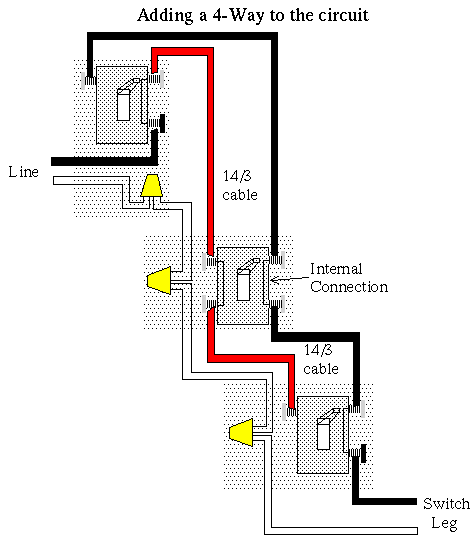 It took about three hours of trial and error, which I did on a Friday so that the lights could be out without bothering Siobhan (and while I could still see by sunlight), but I finally was able to remove the Z-Wave switches that I'd had installed to control my living room lights, and put the manual switches back in. Along the way I learned a lot about four-way switch wiring and how this particular circuit is wired, and I suspect that if I felt confident some four-way switch system would work, I could probably install it myself this time.
It took about three hours of trial and error, which I did on a Friday so that the lights could be out without bothering Siobhan (and while I could still see by sunlight), but I finally was able to remove the Z-Wave switches that I'd had installed to control my living room lights, and put the manual switches back in. Along the way I learned a lot about four-way switch wiring and how this particular circuit is wired, and I suspect that if I felt confident some four-way switch system would work, I could probably install it myself this time.Of course I'd have to be pretty confident. Given that, after almost two weeks, ACT Solutions had not even responded to my email, I think I can safely say none of their products are going to be on the list to be considered. I'm not sure if other manufacturers are making a switch set like this, and if so, if they do better in either the quality assurance or customer service venues. I'm going to let this whole situation rest a while before I even consider it, though.
Figuring out the circuit was a bit difficult because there are two different ways a four-way circuit can be wired. But it turned out in the end that the difference is not significant for what I was doing. It would be for putting in the Z-Wave switches because of them needing power but not for the mechanical switches.
It turns out one of the biggest problem I had was figuring out which contact on the switch was which. The diagrams I was going on suggested they'd be in particular places physically on the switches but that was deceptive, and ultimately I needed to use an ohmmeter to figure out the internal wiring of the switch. That's the kind of thing any electrician would take so for granted they wouldn't even realize a consumer might not know, or might not even realize they didn't know.
I had a similarly obvious problem with the connections. These switches have screw terminals and also have a slot into which you can insert the bare end of the wire. It seems that using the slot is not that reliable. I know that electricians rarely use them, but I wasn't sure if they had a good reason for it or if it's just tradition. It turned out at least with these switches it's for a good reason; even with the screws tightened the slots weren't giving a good contact. I probably had the right configuration once or twice and dismissed it because something wasn't making contact somewhere.
When it finally worked, though, I was exultant and triumphant. It's the kind of job that would take an electrician ten minutes, and took me three hours, but I did it, by myself, without even any advice (not that I ever get useful advice when I ask for it about this sort of thing). And I learned a few things along the way.
Unfortunately I have had no such luck on the floodlight. Odds are I could replace either the lamp itself, or the motion sensor, though it wouldn't be easy for me to figure it all out -- particularly while way up on a ladder. But I am not sure how to tell which is the problem. I think I'll just let this whole problem sit until spring when it'll be easier to work on it, and then see if I can open things up and figure out which part is in need of replacement.

 RealTime and RTC
RealTime and RTC Prism
Prism Uncreated
Uncreated Bloodweavers
Bloodweavers Foulspawner's Legacy
Foulspawner's Legacy Lusternia
Lusternia
No comments:
Post a Comment